
The Piper PA-28 Cherokee is a family of two-seat or four-seat light aircraft built by Piper Aircraft and designed for flight training, air taxi and personal use. The PA-28 family of aircraft comprises all-metal, unpressurized, single piston-engined airplanes with low-mounted wings and tricycle landing gear. They have a single door on the right side, which is entered by stepping on the wing.

Lancair International, Inc. is a U.S. manufacturer of general aviation aircraft kits. They are well known for their series of high-performance single-engine aircraft that offer cruise speeds that surpass many twin-engine turboprop designs. Along with the Glasair series, the early Lancair designs were among the first kitplanes to bring modern molded composites construction to light aircraft.

The Barrows Bearhawk, now also called the Bearhawk 4-Place, is an American amateur-built aircraft, designed by Bob Barrows and produced by R&B Aircraft of Fincastle, Virginia, AviPro Aircraft and now Bearhawk Aircraft of Austin, Texas. The aircraft is supplied as a kit or as plans for amateur construction.

The ADI Stallion is a US civil utility aircraft that first flew in July 1994. It is marketed in kit form for homebuilding by Aircraft Designs Inc.

The Lancair IV and IV-P are a family of four-seat, low-wing, retractable-gear, composite monoplanes powered by a 550-cubic-inch (9,000 cm3) Continental TSIO-550 twin-turbocharged piston engine.

The Cirrus VK-30 is a single-engine pusher-propeller homebuilt aircraft originally sold as a kit by Cirrus Design, and was the company's first model, introduced in 1987.
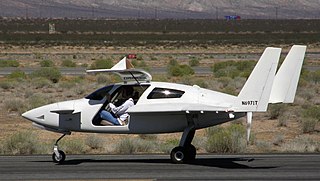
The Velocity Model 173 SE (Standard Elite) is an entry-level canard pusher aircraft from Velocity Aircraft. The four seat, rear engine aircraft may be powered by a 160 hp (120 kW) Lycoming IO-320 or a 200 hp (150 kW) Lycoming IO-360 engine.

The Velocity XL is an American amateur-built aircraft, produced by Velocity, Inc. It is an enlarged version of their Velocity SE canard pusher design.

The Lancair ES is an American amateur-built aircraft that was designed and produced by Lancair. While it was in production the aircraft was supplied as a kit for amateur construction.
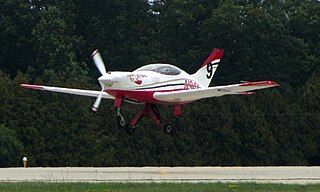
The Questair Venture is a homebuilt aircraft manufactured by Questair at John Bell Williams Airport in Bolton, Mississippi, United States. The aircraft first flew on 1 July 1987.

The Stoddard-Hamilton Glasair II is an American amateur-built aircraft that was designed by Tom Hamilton and produced by Stoddard-Hamilton Aircraft and later Glasair Aviation as a kit for amateur construction. It was first flown in 1989, and remained in production in 2012.

The AeroCad AeroCanard is a family of American amateur-built aircraft, designed and produced by AeroCad of Florissant, Missouri. The aircraft is supplied as a kit for amateur construction.

The World Aircraft Spirit is a Colombian/American amateur-built aircraft, designed by Max Tedesco and produced by World Aircraft Company. The aircraft was publicly introduced at AirVenture in 2011 and production is expected to commence in 2014. It is supplied as a kit for amateur construction or as a complete ready-to-fly aircraft.
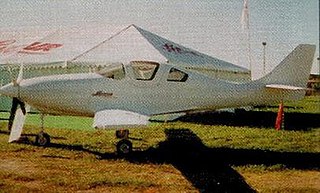
The Lancair Tigress was an American homebuilt aircraft that was designed by Lance Neibauer and intended for production by Lancair of Redmond, Oregon. Introduced in mid-late 1990s, it was essentially a Lancair IV with a much more powerful engine. When the engine was canceled just as it was entering production, the Tigress project ended with it. Only prototypes were produced.
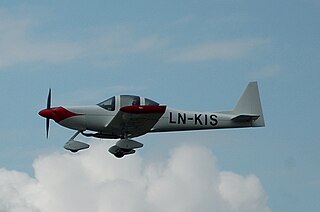
The Tri-R KIS TR-1 is an American homebuilt aircraft that was designed by Rich Trickel and produced by Tri-R Technologies of Oxnard, California, introduced in the 1990s. When it was available the aircraft was supplied as a kit for amateur construction.
The Stratos 714 is an American very light jet aircraft under development by Stratos Aircraft of Redmond, Oregon. The project was announced in July 2008, a prototype first flew on 21 November 2016, although Stratos currently lacks the funding to complete type certification. Predominantly made of carbon composite, the single turbofan aircraft would seat four to six at 400 kn (740 km/h) over up to 1,500 nmi (2,800 km).
The Lancair Barracuda is an American amateur-built aircraft produced by Lancair of Uvalde, Texas. It was introduced at AirVenture in July 2018. The aircraft is supplied as a kit for amateur construction.
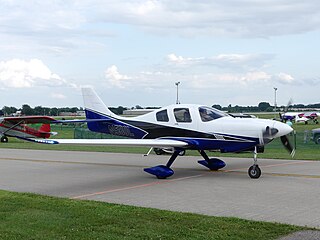
The Lancair Mako is an American amateur-built aircraft designed and produced by Lancair of Uvalde, Texas, introduced at AirVenture in 2017. The aircraft was first flown on 18 July 2017 and is supplied as a kit for amateur construction. It is named after the shark.
The Lancair Sentry is an American amateur-built aircraft that was designed and produced by Lancair of Redmond, Oregon, introduced in 2002. The aircraft was supplied as a kit for amateur construction, although it was also intended as a production military trainer aircraft. First flown in September 2001, only two were ever completed.

The Lancair 200 and Lancair 235 are a family of American amateur-built aircraft that were designed by Lance Neibauer and produced by his company, Lancair of Redmond, Oregon. The Lancair 200 was initially called the Lancer 200, but the name was changed due to a naming conflict. It was first shown at AirVenture in Oshkosh, Wisconsin in July 1985. Now out of production, when it was available the aircraft was supplied as a kit, for amateur construction.























